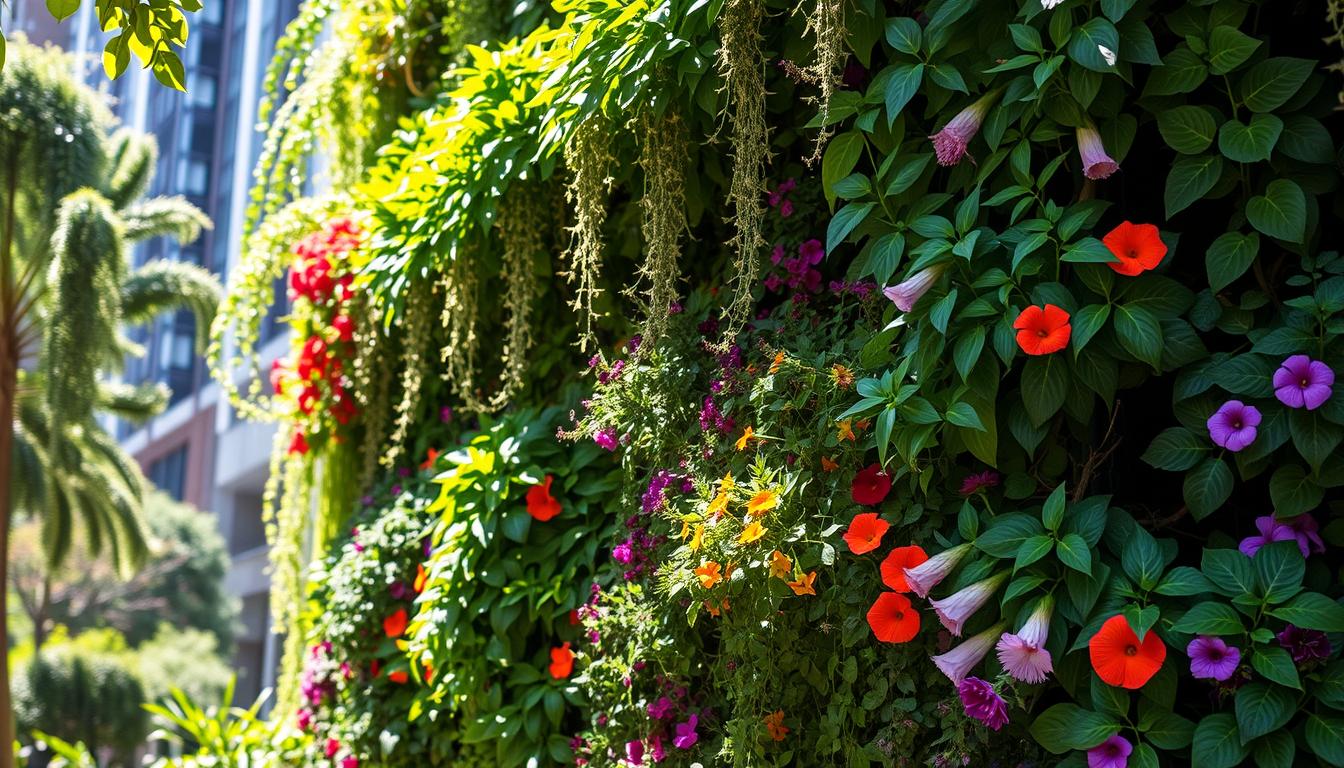Did you know growing your own food can save up to 30% on grocery bills? Edible landscapes are changing how we see outdoor spaces. They mix gardening art with growing food, making our yards useful and beautiful.
This new way of gardening is becoming popular in cities. It helps solve food shortages and protects the environment. By growing food locally, we can cut down on carbon emissions. This shows how combining beauty and food can help our planet.
We’ll look into what edible landscaping is, its benefits, and why it’s becoming more common in cities.
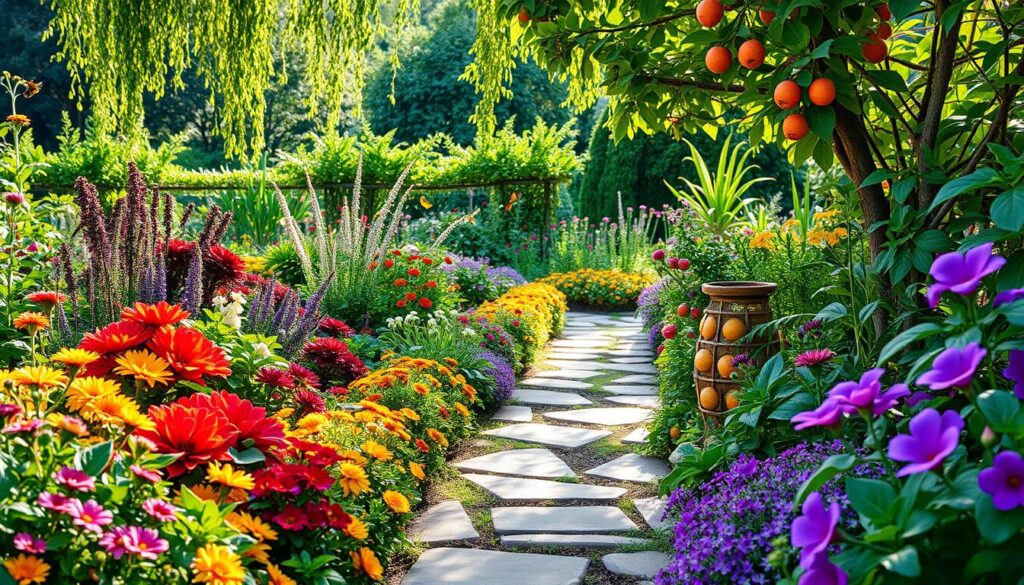
Key Takeaways
- Edible landscaping combines aesthetic design with practical food production.
- This trend allows homeowners to engage in sustainable gardening practices.
- Over 70% of gardeners express interest in incorporating edible plants into their landscapes.
- Local food production through edible landscapes reduces transportation emissions significantly.
- Effective composting methods can boost soil fertility by up to 25%.
- Integrating fruit trees and shrubs in urban settings increases biodiversity and supports local wildlife.
- Utilizing mulch improves moisture retention, reducing the need for frequent watering by up to 30%.
The Definition of Edible Landscaping
Edible landscaping, or foodscaping, combines beauty with usefulness. It mixes plants that produce food into decorative designs. This not only makes spaces look better but also helps the environment by using fruits, veggies, and herbs.
It focuses on having a variety of plants, making spaces that are both beautiful and useful. This way, edible landscapes serve many purposes.
Understanding the Concept
Edible landscaping is about making spaces with plants that you can eat. It uses plants that are native and don’t need much water, which is great for places like Southwest Florida. These plants save water and help local wildlife.
So, edible landscaping is more than just pretty. It teaches us to care for our planet.
The Benefits of Edible Landscapes
Edible landscapes have many good points. One big plus is getting fresh food right from your garden. This means you don’t have to buy as much from stores.
It also brings people together and makes food more secure. This is important for our planet.
- Environmental sustainability through reduced transportation needs for produce.
- Aesthetic enhancements from blending beautiful plants with functional food sources.
- Increased awareness of healthy eating habits among individuals and communities.
- Contributing to local ecosystems by attracting beneficial wildlife.
By adding edible plants to your garden, you help foodscaping efforts. This supports local food making and strengthens community bonds.
| Benefits of Edible Landscapes | Description |
|---|---|
| Access to Fresh Produce | Allows for a consistent supply of healthy fruits and vegetables. |
| Reduced Reliance on Stores | Minimizes trips to grocery stores, leading to cost savings. |
| Enhanced Local Biodiversity | Supports wildlife habitats and promotes ecological balance. |
| Cultural Awareness | Encourages a better understanding of food sources and sustainability. |
The Rise of Edible Landscapes in Urban Areas
Urban areas face big challenges in growing food. As cities grow, many people struggle to find healthy food. Edible landscapes in cities offer a solution, helping communities and solving urban food needs.
Urbanization and Food Production
The world is facing a serious food crisis. Almost 10% of people don’t have enough to eat. Food prices are rising fast in poor countries. Urban gardens can help by turning unused spaces into food sources for local people.
- Edible gardens in cities make fresh food more available, cutting down on grocery bills.
- These gardens can save families 30-50% on food costs.
- Using native plants helps the soil and saves water.
Case Studies of Successful Urban Edible Landscapes
Many cities are showing how to make urban gardens work. The Incredible Edible Network has grown from England to over 100 towns. Projects like the Philadelphia Orchard Project focus on poor areas, creating orchards for local food. These efforts boost property values and community spirit.
| Project Name | Location | Focus Area | Impact |
|---|---|---|---|
| Incredible Edible | UK, Canada, New Zealand | Community Food Systems | Increased local food usage by 25% |
| Philadelphia Orchard Project | Philadelphia, USA | Food Deserts | Enhanced access to fresh fruits |
| Edible Landscapes London | London, UK | Forest Gardening | Promoting biodiverse food production |
These examples show how urban gardens can fight hunger and encourage healthy eating. Gardening also brings more life to cities, improving both physical and mental health. It makes cities vibrant places that feed both the body and the soul.
The Future of Edible Landscaping: Combining Beauty and Functionality
The future of edible landscaping is about blending looks with use. It creates a perfect mix where beauty meets function. New garden designs help make cities greener and more beautiful with edible plants.
Innovative Design Techniques
New design methods are key to edible landscaping’s future. Vertical gardens, for example, use space well in cities. They make places look better and grow more food.
Planting friends together helps plants grow better. Marigolds keep pests away from tomatoes and peppers. Legumes make the soil better for other plants.
Integration with Urban Architecture
Edible landscaping fits well with city buildings and parks. It makes cities greener and brings people together. Edible plants in parks and on rooftops turn cities into food gardens.
Using old and new plant types adds flavor and makes gardens last longer. This makes cities more sustainable.
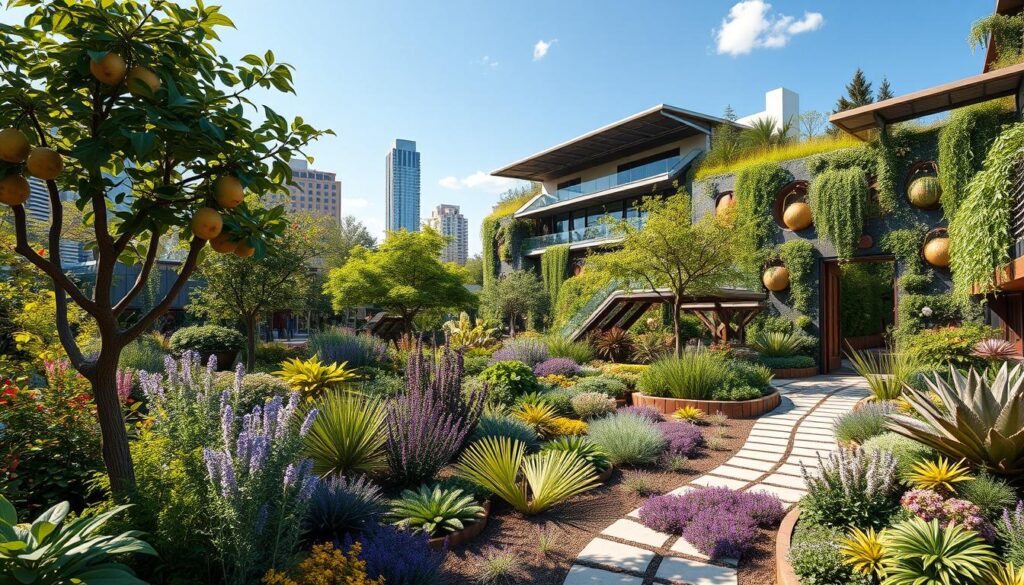
| Technique | Description | Benefits |
|---|---|---|
| Vertical Gardening | Utilizing vertical space to grow plants | Maximizes limited space, increases aesthetic appeal |
| Companion Planting | Planting different species together | Sustains plant health and productivity |
| Integration with Architecture | Embedding edible elements in design | Enhances community interaction, promotes sustainability |
| Diverse Plant Selection | Combining perennials and annuals | Provides continuous harvest; enhances visual interest |
The future of edible landscaping is exciting. It shows that beauty and function go hand in hand. This change makes cities better and ensures food for all in the future.
Sustainable Practices for Edible Landscapes
Sustainable practices are key in creating edible landscapes. They mix beauty with usefulness. Gardeners use smart methods to save resources and grow food. These include saving water and improving soil health, which are vital for a good edible garden.
Water Conservation Strategies
Water-saving methods are essential, more so in dry areas. Drip irrigation delivers water right to the roots, cutting down water use by 30-50%. Rainwater harvesting systems collect rain for watering, making gardens more self-sufficient.
Using organic mulch keeps soil moist, helping plants stay healthy. Also, replacing lawns with native plants can save up to 80% of water, showing the value of green practices.
Soil Enrichment Methods
Improving soil is the base of a good edible garden. Composting, crop rotation, and organic fertilizers make soil better. Compost can hold 15-20% more water, helping plants.
Adding herbs and leafy greens not only boosts production but also looks good. They help keep the garden diverse. Plants like artichokes improve soil health with their deep roots, helping prevent erosion.
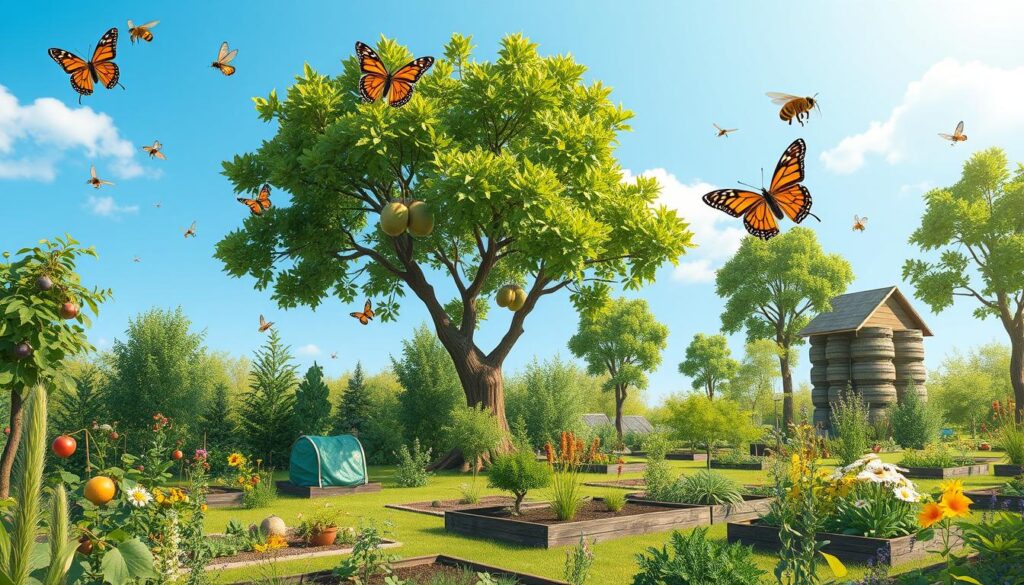
| Technique | Benefits | Impact on Water Use |
|---|---|---|
| Drip Irrigation | Precise water delivery | 30-50% reduction |
| Rainwater Harvesting | Utilizes natural resources | Variable reduction |
| Organic Mulch | Improves soil moisture retention | Up to 70% conservation |
| Companion Planting | Enhances biodiversity and productivity | Supports overall water efficiency |
| Drought-Resistant Plants | Reduces maintenance and increases resilience | Up to 80% conservation |
Designing Your Own Edible Landscape
Turning your outdoor space into an edible landscape can be amazing. By picking the right edible plants for your area, you get a garden that looks great and works well. It’s all about choosing plants that are both beautiful and useful, helping the planet too.
Choosing the Right Plants
When you’re designing an edible landscape, think about what your garden needs. Here are some key points to remember:
- Climate and Soil: Find out which plants do well in your climate and soil.
- Companion Planting: This method can help plants grow better and keep pests away, boosting your harvest by 20%.
- Seasonal Selection: Mix perennials and annuals for a constant supply of fresh food all year.
- Edible Flowers: Add plants like nasturtiums for their taste and beauty.
Creating Visual Harmony with Functional Elements
To make your garden both beautiful and useful, focus on visual harmony. Here are some tips to help:
- Height and Layering: Use vertical gardening to save space and add interest.
- Color and Texture: Choose a variety of plants for different colors and textures that catch the eye.
- Outdoor Spaces: Adding places to sit can make your property more valuable, combining beauty and function.
- Pest Management: Pick plants that keep pests away to create a healthier garden and cut down on chemicals by up to 30%.
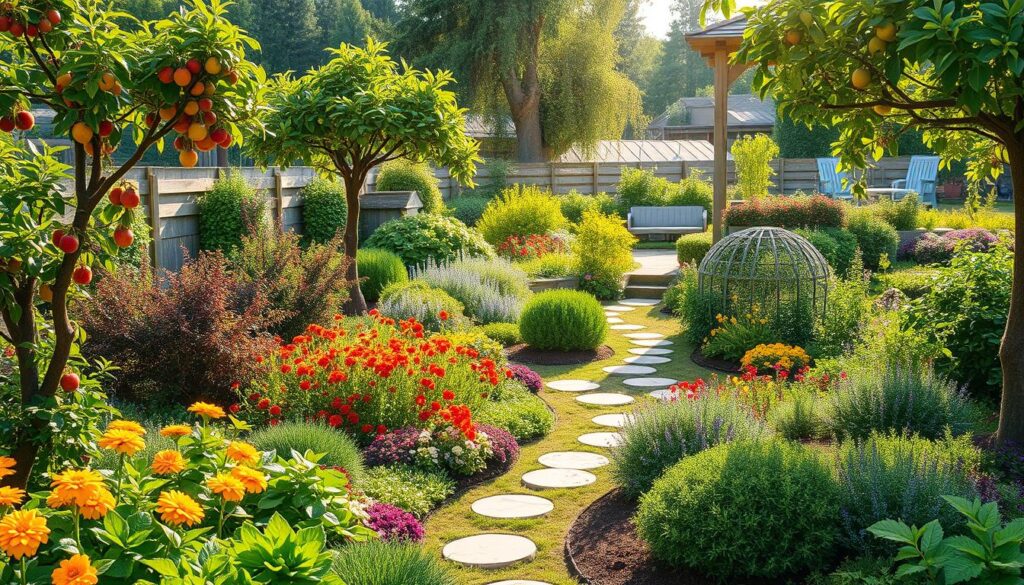
Functional Gardening: The Balance of Form and Function
Functional gardening aims to blend beauty with usefulness. It uses every inch of space and encourages a variety of life. By choosing plants that look good and serve a purpose, gardens become both beautiful and useful.
Utilizing Space Efficiently
In cities, every inch of space is precious. Techniques like intercropping and vertical gardens help use space well. For instance, artichokes can grow in small spaces, reaching three to five feet tall.
They need well-drained soil and lots of sun to grow well. This makes them a great choice for small gardens.
Promoting Ecosystem Diversity
Having many different plants in a garden makes it stronger and more productive. Adding plants like artichokes and marigolds keeps pests away and attracts helpful insects. This approach not only makes the garden healthier but also makes it more productive over time.
Diverse gardens have better soil, prevent erosion, and create their own climates. With careful planning, gardens can be both beautiful and good for the environment.
Current Trends in Edible Landscaping
Edible gardening is changing, blending beauty with usefulness. Homeowners want gardens that feed them and look good. This has made certain plants very popular.
Popular Edible Plant Selections
Some of the most wanted plants are:
- Tomatoes: They come in many varieties and are very nutritious.
- Peppers: They add color and taste to any garden.
- Herbs: They’re key for cooking and add beauty to the garden.
- Dwarf fruit trees: Perfect for small spaces, they give a lot of fruit.
- Perennial herbs: They grow back year after year with little effort.
Using native plants is also big. They need less water and care, helping the environment.
The Importance of Seasonal Gardening
Seasonal gardening is key for a garden that grows all year. Homeowners should:
- Check the local weather to know when to plant.
- Use companion planting to keep plants healthy and pest-free.
- Make the soil rich with compost to help plants grow.
Watering and caring for the garden are also important. For example, tomatoes need about 2 inches of water a week. Bell peppers need 1 to 2 inches. Knowing these needs helps make a garden that works well.
| Plant | Watering Needs | Soil pH Range |
|---|---|---|
| Tomatoes | 2 inches weekly | 5.6 – 6.8 |
| Bell Peppers | 1 – 2 inches weekly | 6.5 – 7.0 |
By mixing popular plants with seasonal gardening, gardens can be both productive and beautiful. This way of gardening is good for the planet and helps us connect with nature.
Community Engagement through Edible Landscapes
Edible landscapes help communities come together. They create spaces where people can work together. This leads to a sense of pride and stronger bonds among neighbors.
Encouraging Local Participation
Community gardens are key in getting people involved. They host workshops and events where people can share food. This helps build connections and a sense of belonging.
Through these efforts, communities can grow closer. People work together to make their spaces beautiful and productive.
Building Connections with Nature
Edible landscapes help us connect with nature. Gardening improves our mental and physical health. It also makes us eat healthier.
By caring for plants, we learn to respect the environment. This awareness is vital for living sustainably.
| Benefits of Community Engagement | Impact |
|---|---|
| Enhanced Food Security | Increased access to fresh produce through local gardens |
| Improved Mental Health | Reduction in stress and anxiety through gardening activities |
| Stronger Community Ties | Building relationships among neighbors through shared projects |
| Environmental Awareness | Encouraging sustainable practices and biodiversity |
Edible landscapes and community involvement make neighborhoods better. They promote wellness and sustainability. This benefits everyone in the community.
Conclusion
Edible landscapes are a new way to make outdoor spaces better. They mix beauty with useful features in gardening. This approach can change how we use our surroundings, helping local food and health.
The future of edible landscapes is bright. More people want to live sustainably and grow food nearby. This trend is exciting for our communities.
Edible landscaping does more than look good. It offers fresh food, smart planting, and plants that help the planet. It also brings people together through gardening.
In cities, we need to use space wisely and care for nature. Edible landscaping helps save money and ensures we have food nearby. Gardeners, planners, and leaders should support this idea.
This way, we can make our gardens better and improve our lives. It’s a step towards a greener, healthier future.
FAQ
What is edible landscaping?
Edible landscaping combines food plants with ornamental ones. It turns outdoor spaces into gardens that are both beautiful and productive. These gardens provide fresh food and help local wildlife.
What are the benefits of edible landscaping?
Edible landscapes offer fresh produce right in your yard. They reduce the need for store-bought food and help the environment. They also make your area look better and support community health.
How can I start my own edible landscape?
Start by picking plants that grow well in your area. Mix edible and ornamental plants for a balanced look. Use local and seasonal plants to help the environment.
What innovative design techniques can I use for urban edible landscapes?
Try vertical gardening, companion planting, and permaculture for urban spaces. These methods use space wisely and look good. Adding food-producing elements to buildings can make designs even better.
What are some water conservation strategies for edible landscaping?
Use drip irrigation, collect rainwater, and mulch to save water. These steps are key for a productive garden, even in dry areas. They also protect our water sources.
How can functional gardening help maximize space?
Functional gardening uses space well with intercropping and vertical systems. It also promotes plant diversity. This makes gardens more resilient against pests and diseases.
What are the current trends in edible landscaping?
Trends now include superfoods, heirloom plants, and native species. Gardening with the seasons is also popular. These approaches help gardens grow well and support a healthy ecosystem.
How do edible landscapes foster community engagement?
Edible landscapes bring people together through community gardens and workshops. They help build friendships and connect us with nature. This improves our mental health and encourages healthy eating.
Source Links
- Transforming Your Landscape: The Art of Edible Landscaping Unveiled
- Beauty in Abundance: Designs and Projects for Beautiful, Resilient Food Gardens, Farms, Home Landscapes and Permaculture 1737841304, 9781737841302 – DOKUMEN.PUB
- Resilient Gardens Bend to the Will of Mother Nature
- Southwest Florida Landscape
- Edible Gardening and Foodscaping
- Edible Landscapes: A Guide to Fighting Food Scarcity – Florida Edible Landscapes: Grow Your Own Paradise
- Edible Landscaping: The Next Landscaping Trend? –
- 15 Organizations Creating Edible Landscapes
- Edible Landscaping Summary PDF | Rosalind Creasy
- Integrating Artichokes into Edible Landscaping
- Edible Landscaping: Food and Beauty in Your Yard
- Integrating Artichokes into Edible Landscaping
- Sustainable Landscaping: Eco-Friendly Outdoor Design Practices
- Edible Landscaping: How to Grow Food Beautifully – Naylor Creek Gardening and DIY
- Edible Landscape Plants: Growing Your Own Food in Your Backyard
- From Garden to Table: Designing Your Edible Landscape
- Integrating Artichokes into Edible Landscaping
- Foodscaping: The Most Beautiful Way To Grow Your Own Food
- Edible Landscaping and Syntropic Gardening – Cultivating a Resilient, Sustainable Future
- Harvest Your Yard: How to Design an Edible Landscape
- 2025 Landscaping Trends: The Future of Outdoor Living Spaces
- Gardening Trends 2025: What Garden Center Owners Need to Know | Dig Marketing
- Designing Paths in Edible Landscapes
- Enhance your Garden with Edible Landscaping Shrubs
- Socio-Cultural Appropriateness of the Use of Historic Persian Gardens for Modern Urban Edible Gardens
- The Art of Edible Landscaping:
- Agri Articles (E-Magazine) 04(05) 2024



